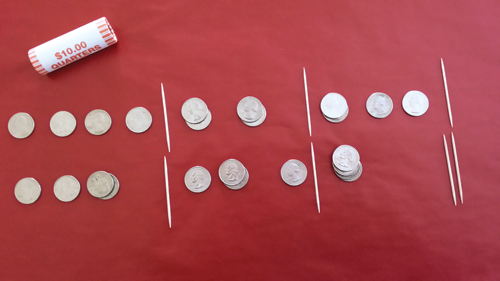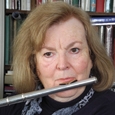When listening to auditions, I evaluate the flutist’s playing in a matter of seconds. My first impression is in the area of sound. The topic of sound includes the correct notes played in tune, at the proper dynamic, and with the appropriate focus and color. Next, I listen for rhythm. There are two kinds of rhythm: audition rhythm and orchestral rhythm. For audition rhythm the flutist should play exactly as if a metronome is clicking in the background. Orchestral rhythm comes from playing with an orchestra and is based on a conductor’s preferences concerning expression as well as musical traditions that have been passed down through history. Flutists with a great deal of orchestral experience often have difficulty winning auditions because they play the way they know the works will be performed rather than in a strictly metronomic manner. I am not sure how these two approaches to rhythm developed, but I do know from sitting on various audition committees, that they exist. The final part of my listening process is evaluating the player’s musicianship.
While most students will not be auditioning for top tier orchestras, I prepare them as if they will. My first teacher, Frances Blaisdell, told me she strived to teach each of her students as if they would eventually play principal flute in the New York Philharmonic. I like this commitment to excellence and attempt to follow her example.
Recently a reader wrote asking for advice in teaching a student who “has the worse sense of rhythm ever.” There is no magic formula to cure this because every student is different, but there are several options to explore.
Check the Reading Process
For students with significant reading and rhythm problems, start by asking when they last had an eye test. I find that many have never had an eye examination or perhaps just basic testing in school. It is amazing how much notereading and rhythmic reading improves when everything on the page is not blurry.
Re-Teaching Rhythm
If a student who is having rhythm issues is older, it may be best to reteach finding the pulse in music and music notation. To help students find the pulse, ask them to walk or move to a CD playing various musical styles. Begin with folk and nursery songs before advancing to works that have a less obvious pulse. Teachers who play piano can play passages and speed up or slow the pulse.
While playing on the headjoint is usually a pedagogical tool for teaching beginners, it is equally valuable for older players. I regularly practice slurring octaves on the headjoint to develop embouchure flexibility. For students with rhythmic problems, practicing on the headjoint eliminates issues of balancing the instrument and fingering the notes so students can concentrate solely on the rhythm.
Echo
In 4/4 meter I play one measure using only whole, half, and quarter notes. I play a rhythm and then have students echo what they hear back to me. If this goes well, we exchange places and the students create a rhythm using these note values that I echo back. As students become more adept at this, I alternate playing several notes in a different register as a beginning exercise to develop the ear. I start every lesson with this exercise for several months, and gradually add to the complexity of the rhythm. My goal is for students to understand the rhythm aurally before being presented with the task of reading the rhythm.
Teaching a Code
The first step in teaching notation to younger students is to relate the rhythmic proportions of music to something they already understand – money. A roll of quarters is a good teaching aid. Tell them that one quarter is a quarter note. Two stacked quarters is a half-note. Three stacked quarters is a dotted half-note. Four stacked quarters is a whole note. Explain that music is organized by meter such as 2/4, 3/4, or 4/4. Create one measure in 4/4 meter visually for students with quarter notes by positioning four quarters in a row on a table. Touch each quarter from left to right as the student plays a note on the headjoint in time with your pointing. Repeat several times.
Then in ping pong style (alternating back and forth between teacher and student) play the measure several more times. Explain that this rhythmic example is one bar or measure in 4/4 meter.
Create another measure (stack two quarters for a half-note for the rhythm half, quarter, quarter ) and repeat the process of pointing to the money while the student plays and then practice the measure ping ponging. Next explore the rhythms of quarter, quarter, half; quarter, half, quarter; half, half; and whole.
At this point switch have the student create a 4/4 measure for you to play. As students develop an understanding of this concept, lengthen the examples to include two, four, and eight measures. Place a tooth pick between the quarters to represent a bar line. You could use a small stack of Legos or other items to symbolize quarter, half, and whole rests. Sometime I play the measure incorrectly to see if a student is listening carefully.

Other Ideas
When I was a student at Eastman, the theory curriculum included part-writing, aural skills and keyboard harmony class. In aural skills we worked on dictation (all four parts, not just soprano and bass lines) and on sight-singing. The skills I learned from this class are ones I have used my entire musical life.
For sight-singing, we were presented a melody that we had never seen before and did the following. The right hand conducted the beat pattern, while the left hand tapped the background (simple or compound time) on the desk. All this was done while singing the note name on the correct pitch and in the correct rhythm. It took practice and concentration to coordinate doing all these elements at once, but once I could do it, the quality of my sight-singing greatly improved.
To this day, I use these elements when I am learning a new piece. If I can conduct the composition while singing and tapping the background, I am prepared for the rehearsal and concert. Even when I am preparing something that I have performed before (i.e. Dumbarton Oaks), I go through these steps again to hone my skills.
At the time, I asked my teacher why we were being tortured – because it did feel like torture. He said the creator of this curriculum, Allen J. McHose, thought that the more body parts you get involved and organized, the better the understanding.
So while working with the quarters, I also ask students to tap the pulse first which the right foot only (rocking on the heel from the ankle), then the left foot only, then both feet together, and finally alternating the left foot and the right foot. This alternation of foot tapping is sometimes called cello-style foot tapping.
Written Notation
The blackboard in my studio has several painted staves. If you do not have a blackboard, staff paper will work as well. The next step is to equate the money (each quarter) with written symbols of the quarter, half, dotted half, and whole notes. After practicing reading the above rhythms written in standard notation and executing them accurately, a student is ready to proceed into a beginning method book or rhythmic studies book. When working with slightly more advanced students, I have them sing the passage while clapping the rhythm and then sing while clapping the rhythm on each leg. Another useful technique is to have students say “sh, sh, sh, etc.” to the rhythm. This is especially beneficial for wind players because it brings wind coordination into the mix.
Lack of Rhythmic Pulse
Some students intellectually understand rhythmic notation, yet have difficulties executing certain rhythmic passages well. When patting their foot, they often play the and note before the foot is in the up position and then play the next down too soon. Wind players who have a headjoint or mouthpiece are unable to count aloud and as a result come to believe that feeling the pulse is counting. I have had great success with the voice feature on some metronomes that counts the beat numbers out loud. I personally use this feature when learning new works especially ones that have many meter changes. I encourage students to work with the this feature as it adds a spoken input into their counting.
Some students seem to lack the ability to sense a steady rhythmic pulse. One theory is that they may have spent too much time the first year of their lives in an infant seat rather than being carried next to the mother’s heart. Whether this is true or not, the problem exists. The following exercises can help students feel a steady beat.
Pendulum Exercises
• Rock in a rocking chair concentrating on how far forward and back each cycle is. Use the metronome clicking on the forward or back position turning point.
• Jump rope and swing the rope at varying tempos. The metronome can also be used with this exercise.
• Roll a ball to a partner in time with a metronome. Early childhood researchers have said that a ball is the best toy for a child. In Montessori classes, I observed young children rolling a ball back in forth in time with the music. They soon discovered that the faster the music went, the closer they had to be to one another. Tennis players are instructed to bounce the ball a few times before they serve. A tennis teacher told me this was to get the rhythm of the ball in my head before I served.
Large Motor Skills
Ballroom and tap dancing classes are beneficial for teaching people to coordinate large muscles with a beat.
Tick-Tock
Replace a digital alarm clock with a wind-up ticker so the student hears the steady pulse of the clock while sleeping.
Count Aloud
Counting aloud, while doing repetitive motions such as climbing stairs or sweeping a walk or shoveling snow coordinates the mind with the muscles. For swimmers, suggest they try to count the time in between breaths.
Juggling
A regular feature of my summer flute camps was to teach everyone to juggle. One student asked why we were doing this and I said, “Just wait, you will figure it out.” A few minutes later he responded, “Oh, this is about counting and waiting – just like in music.”
In a perfect world, all students would be rhythmic. In the real world, teachers have to look for a variety of methods to develop this skill. Because everyone learns differently, it can take a great deal of creativity to find methods that resonate with each student. Share ideas that have worked with your students (or yourself) on the Flute Talk Facebook page.






